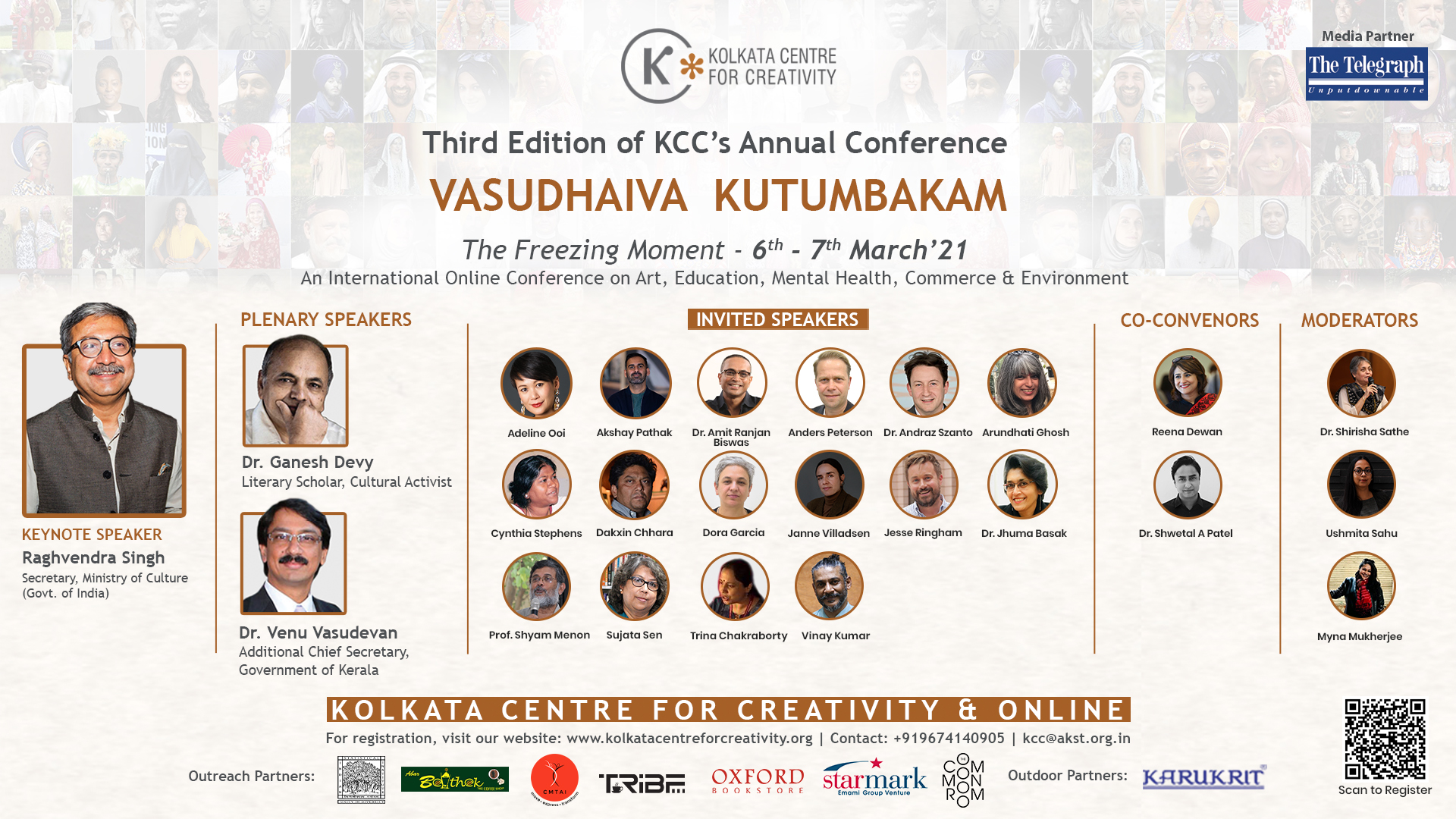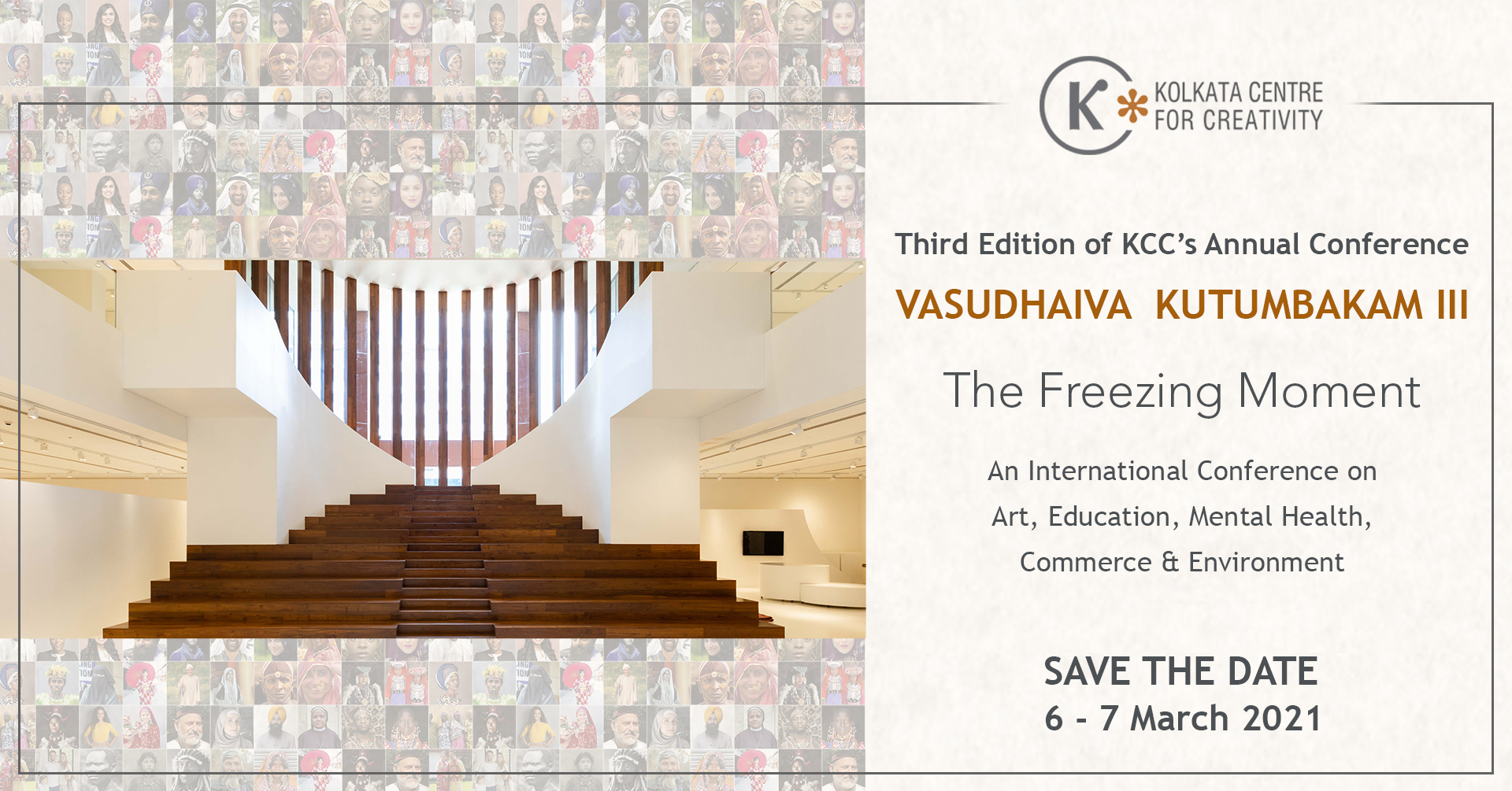Vasudhaiva Kutumbakam III: The Freezing Moment
Looking back over recent times, in which the Covid-19 pandemic swept the whole world to a virtual standstill, the third edition Vasudhaiva Kutumbakam explored topics including education, art production and policy, mental health, commerce, activism and the environment. It continues to be an extraordinary and unpredictable time—one that modern human civilization has rarely encountered on such a global scale. Many of the things that we took for granted have been taken away, or at least paused indefinitely. Businesses have been shuttered, domestic and international travel has stopped, and the socially driven human practice of gathering has been suddenly halted. As humans sheltered for a while, under lockdowns the world over, nature took its chance to rejuvenate and flourish. Despite this, in those frozen moments of uncertainty, so much has ensued. New possibilities have been imagined and created. As we continue the process of containment and recovery from the pandemic, we stand at a crossroads, and many new pathways now seem possible. Not many things have remained as we had previously expected. The third edition of the annual conference of Vasudhaiva Kutumbakam at Kolkata Centre for Creativity, therefore, aimed to look back, whilst also conjecturing future possibilities. KCC invited practitioners, experts and the public to gather together to rediscover the treasures that could arise from these continuing moments of gloom and desperation, allowing us the possibility to build a better and more equitable future for our planet. Vasudhaiva Kutumbakam 2021 also built upon the two previous editions of the annual conference, which began in 2019. Outcomes from Vasudhaiva Kutumbakam continue to inform our progress at the Kolkata Centre of Creativity and we look forward to inviting physical and online audiences in India and around the world to join us once again. |

Day 1
1. Art Policy
The decimation of the economy took a heavy toll on the field of art and art commerce. Immediately after the break out of the pandemic, most funding organizations and agencies stalled their support and many sponsorships and grants were stopped or delayed indefinitely. The total halt to live performance and physical exhibitions have left many art practitioners and artisans’ jobless and underemployed.
What changes can be made to government art policies that may help art recover from this challenging situation? What can institutions and galleries do to help the sector and what are the new protocols and standards we should aspire toward?
2. Digitalization of the Arts
As soon as physical gatherings were restricted due to new pandemic regulations, live performances also had to be reimagined or cancelled altogether. However, the artistes’ community did not sit idly by, they began exploring the virtual realm. Through the mediation of cameras and Internet connections, artists began developing their homes into performance spaces. Many different kinds of experiments began to take place. On one hand, this trend hints towards the development of new media and digital art, on the other, it raises questions about the agency of creators, audiences and mediators in this time of crises. The fear of state censorship also raises many questions for performers and artists, as does the economic effects upon performers and venues.
What is the direction of digital performance and how will this affect the tradition of live performance? What impact will digital performances have on the livelihoods of artists and how will they be remunerated for their performances? Is the digital realm a viable alternative to public performances and who stands to benefit the most?
3. Education
a) Rehabilitation of children
Education is considered as one of the 6 fundamental rights according to the Constitution of India. Schools run by the state in India are not only institutes that provide education, but they also play a major role in child rehabilitation, whilst keeping track of the dropouts and child labour infringements laws. Schools help our society in preventing child trafficking, child abuse and other dangers young people face in the country. Schools provide a mid-day meal, a system that ensures that basic nutrition needs for rural and urban underprivileged children are met. When the lock-down happened this system was adversely affected. While the gap of a year in formal education is something manageable, deterioration of the other infrastructure and services is extremely alarming for the future of a growing nation.
What strategies can we utilize to rehabilitate the schooling system irrespective of re-opening of schools? What methods are being developed to bring children back to the childhoods they deserve? What can the art fraternity do to help improve children’s lives during this difficult time? What does the future of education in State-run schools in India look like?
b) Mental health in Education
As the pandemic affected the education system in India, it also clearly showed the ineffectiveness of digitalization in India. The pandemic affected not only students, but also teachers and policy makers, all of whom suffered in different ways. Hence, it is important to ponder on the mental health of students, teachers and managers and also analyze the special education system in this context.
How are these stakeholders dealing with the situation? How did the pandemic affect education groups and how are they sustaining themselves during this period? Whilst we are exploring special education, we also need to learn and listen to parents, teachers, students and NGO’s in the sector.
Day 2
Activism
4. Protest against discriminatory oppression
In the background of the protests against discriminatory CAA and NRC laws in India, the Coronavirus broke out. The movement was unique in its expression as it took various artistic actions to convey its political agenda.
Likewise, during the COVID pandemic, and after the sad demise of George Floyd at the hands of US police, a global anti-racist movement spread through the world in the name of ‘Black Lives Matter’. That movement also used different artistic approaches, including the use of performance, music and social-media to promote its viewpoint.
These may not be isolated phenomena developed during the Covid-19 pandemic. Art has always been a weapon of the oppressed to protest against discriminatory oppression.
These movements also bring about the age-old debate about the purpose and efficacy of art in achieving political aims.
What is the significance of the arts in bringing expression to activism?
How has art inspired and influenced contemporary activism in India?
What is the anthropological connection between Art and Human Rights that facilitates, nurtures and explains this phenomenon?
5. Environment & Sustainability in Arts
When the world stopped – the natural world flourished. As we were restricted to our man-made habitats the natural world fought back to reclaim the seas, skies and forests – free from our polluting infiltrations.
Now as we begin returning to our previous rhythms and habits, the arts sector has also started opening up fairs and festival opportunities, leading to increased travel.
What learning’s from the ‘frozen moments’ can we continue implementing in the art world, especially in the celebrations of arts – the festivals, biennales and carnivals? How can we make post-COVID-19 art gatherings more sustainable for the environment?
6. Commerce
The growing market of festivals, fairs and biennales received a big jolt due to the sudden halt caused by Covid-19 crisis. While they are essential to keep the wheels of the Art Economy running, their numbers and frequency are mounting pressure on resources, both economic and ecological. Since some of them had a tryst with a complete Digital platform this year, probably we are ready to relook and rediscover them differently.
How viable Hybrid formats are? Can we restructure them to cover up for the reduction in physical interactions? Who will decide how much is enough? Can some policies be formed to weave-in factors that ensure environmental sustainability? Is it possible to merge some of them to reduce the overall number?
- Dr. Shubhra Nag
- Nobina Gupta & Saptarshi Mitra
- Mansav Arora & Vanika Saberwal
- Dr. Rinita Mazumdar










